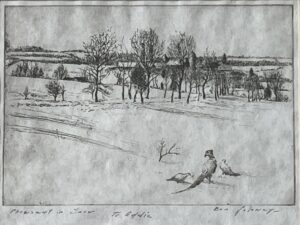In a letter to her friend, writer Helen Papashvilly, Rae recalled Ben’s introduction to etching.
“The last time we visited Canada Lake, New York, in the Adirondacks [in 1974], one of the homes of our late friend, Paul Bransom, a great animal illustrator, and while retired many years, Paul retained his etching press in his studio there.
With his usual curiosity in any and all media, Ben was examining this gargantuan machine. At which point, Paul said, “Ben if you’re at all interested in trying your hand, I’d like you to take this along to your studio.” Of course, Ben was elated at the thought of it. While I said nothing, wondered how this beyond -belief-in-size press could possibly fit into a car!
You’ll believe this or not, by Ben took the entire thing apart, tagged each section, stacked the whole thing, and when we returned to the studio – not one part lost or missing. He was able to get it into working condition without any effort! Even more remarkable, Ben asked a few questions, but essentially, by getting all the books he needed on etching, he did some quite remarkable etchings. At age 74, to feel inclined to attempt an entirely new medium, and so successfully, is a measure of his wide-ranging interests. He looked forward to doing so much more in this medium.”
The etching press was set by the windows in the Second Studio and many of the images are landscapes seen right outside those windows. In his final four years, Ben produced an impressive collection of prints, both etching and drypoint. Despite the fact the etching process could give him a number of identical prints of the same image, it is somewhat characteristic that Ben was continually experimenting, consequently making each print a unique work.
For instance, Ben might create a plate, and pull an initial print, then pull the next on a different type of paper. He might continue adding to the work and experiment with that version or “state.” He frequently made notations on the bottom left corner of a print as a record of the print’s evolution. Earlier prints were not considered inferior to succeeding prints, just different from the subsequent images. Ben never produced a numbered edition of any of his etchings and did not make notes of how many prints were pulled. Each work is unique
In the Reiskin Collection is an etching titled “Pheasant in Snow,” perhaps Rae’s favorite print. This particular print was inscribed “To Eddie,” who was the Reiskin’s son. It is the only known print of this image to be both titled and signed. It is also one of only two Solowey prints that were variations of an existing drawing. In our collection we have the original drawing with a mylar overlay with a hand drawn grid that Ben used to transfer the drawing in a smaller size to fit on his copper plate. In the transition, he added pheasants. Ben loved drawing birds, and on the shelf of his easel, visitors can see a scrap of board on which Ben drew a number of birds that he probably saw out his studio window. Birds in winter was a theme he repeated in drawings and in prints, and the Reiskin Collection also include two other etchings , A Flock of Birds, and one of the few non winter bird scenes, The Sail, which shows herons on Lake Nockamixon.











